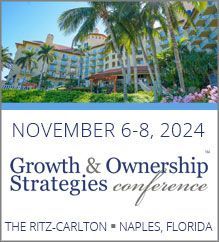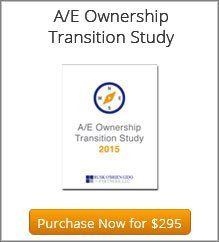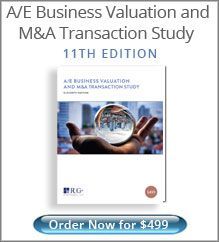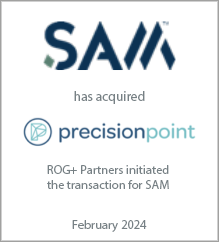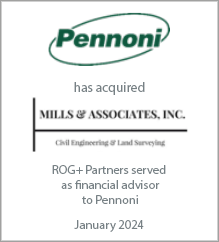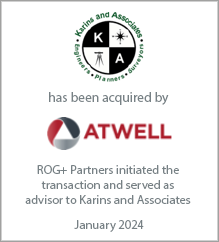Steve Gido specializes in corporate financial advisory services with a focus on mergers and acquisitions. Steve has assisted architecture, engineering, environmental consulting and construction firms of all sizes across North America achieve their growth or liquidity goals through successful mergers & acquisitions. Steve has over 15 years of investment banking experience and holds the chartered financial analyst (CFA) designation from the CFA Institute.
Five Takeaways on 2016 A/E M&A Activity
Five Takeaways on 2016 A/E M&A Activity
December 5, 2016
Well, you can’t say that 2016 has been dull. In a year that produced memorable comebacks, upsets and surprises across a spectrum of institutions, whether it was geopolitical (Trump victory, Brexit referendum), financial (Dow 19,000), sports (Cubs and Cavaliers’ wins, Villanova’s buzzer-beater) or cultural (alas, Brad and Angelina), the country is due for a much needed breather after these wild 365 days!
Given this setting, A/E executives pulled back and took a measured, “wait & see” approach to deal making this year. By our tabulations, the number of 2016 North American A/E and environmental consulting transactions will be down about 8% from 2015 levels. Overall we’re rather impressed at the resiliency and interests of both buyers and sellers in an otherwise turbulent period. When you consider the nonstop melodrama and uncertainty of the election, depressed oil prices, growing number of CEO successions, and a “stop & start” A/E industry defined by persistent unevenness, the fact that as many exciting combinations came together is a testament to the core M&A motivations of an ever-consolidating industry.
In fact, recent conversations with A/E executives and corporate development teams indicate a general relief that the election and rhetoric is over. Furthermore, many feel a promising (and overdue) renewal of American infrastructure, energy, building and environmental investments may be on the horizon. As a result, leadership teams are assessing the “where’s and how’s” of their 2017 planning exercises and it’s clear that acquisitions are a critical part of that effort and execution.
Notable A/E M&A takeaways include the following:
5. But are we reaching the top of the industry cycle?
Although both the macroeconomic and A/E recoveries have been relatively slow and sluggish since 2010, they haven’t been outright recessionary. The U.S will enter 2017 in its third-longest recovery without a recession since the Great Depression, so an argument can be made (as some prominent banks and economists have done) that the likelihood of a recession will rise. Interest rates are heading higher, inflationary forces may accelerate, and there is always the possibility of a systematic or event-driven risk that policymakers can’t predict. We saw this in 2007. We’ve spoken with A/E executives who privately express their firm’s growth and profitability levels are topping out while here at ROG we’ve mused if the A/E industry can truly reaccelerate its growth. In the long-run, M&A is a confidence game on outlook and convictions, so time will tell.
At Rusk O’Brien Gido + Partners, we possess strong relationships and years of experience navigating A/E and environmental buyers and sellers through the M&A process and towards winning combinations. Whether you are seeking to grow through acquisitions or by evaluating your firm’s strategic and ownership alternatives, please contact us as to how we can help your organization.
On a final note, Season’s Greetings and a happy, healthy and prosperous New Year from all of us here at ROG + Partners!
Given this setting, A/E executives pulled back and took a measured, “wait & see” approach to deal making this year. By our tabulations, the number of 2016 North American A/E and environmental consulting transactions will be down about 8% from 2015 levels. Overall we’re rather impressed at the resiliency and interests of both buyers and sellers in an otherwise turbulent period. When you consider the nonstop melodrama and uncertainty of the election, depressed oil prices, growing number of CEO successions, and a “stop & start” A/E industry defined by persistent unevenness, the fact that as many exciting combinations came together is a testament to the core M&A motivations of an ever-consolidating industry.
In fact, recent conversations with A/E executives and corporate development teams indicate a general relief that the election and rhetoric is over. Furthermore, many feel a promising (and overdue) renewal of American infrastructure, energy, building and environmental investments may be on the horizon. As a result, leadership teams are assessing the “where’s and how’s” of their 2017 planning exercises and it’s clear that acquisitions are a critical part of that effort and execution.
Notable A/E M&A takeaways include the following:
1. A solid year for mid-sized deals
– With the exception of the Stantec-MWH Global merger, 2016 failed to produce other large-scale, transformational combinations. However, underneath that level, there were a number of intriguing deals among ENR 500 mid-sized firms, most notably in architecture and facility engineering, such as: NV5 acquiring both JBA Consulting Engineers and Sebesta; Day & Zimmerman – Hankins & Anderson; DLR – Westlake Reed Leskosky; and Stantec – VOA Associates. And while publicly traded firms were somewhat quiet with the active exceptions of Stantec, NV5 and KBR, private equity backed A/E and environmental firms continued to recapitalize, acquire new platforms, and add niche targets to existing portfolio companies. Companies here include ATC, Jensen Hughes, Trinity Consultants, Cumming, RES, Surveying & Mapping, and Environments for Health Architecture.
2. The Sunbelt is where it’s at.
While a sizable number of industry transactions are motivated by fortifying local or regional footprints, M&A goals for geographic diversification continue to be dominated by pursuits to the South. Admittedly, this has been going on for many years and not a huge surprise given national trends in population migration, immigration, household formations, new industry clusters (energy, industrial, manufacturing, tourism), and their direct correlations in design and building activity. However, the Sunbelt deal trend is most certainly accelerating. Active engagements as well as talks with Presidents and Principals on desired target criteria profess a continued appetite for A/E and environmental consulting firms from Virginia through Florida, across the Gulf Coast into Texas, and westward through Southern California.
3. A tough hiring climate tilts the “buy vs. build” calculus.
The one clear takeaway from our recent Growth & Ownership Strategies Conference in Naples, as well as our conversations with industry recruiters and human resources managers, is that quality architecture, engineering and environmental professionals are simply in high demand. There is a consensus lament of being unable to consistently find (let alone hire!) people at practically all levels and disciplines (incidentally, this is also problematic with construction firms everywhere). As a result, signing bonuses, multiple bidding wars, and escalating offers are back in vogue as candidates ponder their career options compared to the uneasy environment of just five years ago. Given that tighter labor pools are a constrictor to growth and project delivery, the economics and efficiencies of acquiring talent through M&A as opposed to incremental organic methods is increasingly appealing.
4. On the one hand, future infrastructure spending looks bright.
It’s increasingly likely that U.S. infrastructure spending could be a major policy, economic and jobs driver for the Trump administration. In fact, E&C stocks have rallied since the election in anticipation that their companies will be direct beneficiaries of major investments in new roads, bridges, pipelines, dams, ports and tunnels. Obviously, the amount, timing and composition of such a massive legislative package will have to be negotiated as well as how it will ultimately all be funded given budgetary pressures elsewhere. At the state level, voters approved major transportation and education construction-related initiatives in Colorado, Texas, California and North Carolina with a combined value in excess of $135 billion. Engineering firms with dedicated expertise in civil and transportation/transit are well positioned and promising acquisition targets.
At Rusk O’Brien Gido + Partners, we possess strong relationships and years of experience navigating A/E and environmental buyers and sellers through the M&A process and towards winning combinations. Whether you are seeking to grow through acquisitions or by evaluating your firm’s strategic and ownership alternatives, please contact us as to how we can help your organization.
On a final note, Season’s Greetings and a happy, healthy and prosperous New Year from all of us here at ROG + Partners!
Latest Perspective
Perfecting the A/E Exit Strategy – Five Key Factors
An enormous A/E generation that kicked off their careers in the 1980s and subsequently started firms or became owners in the 1990s ...
© 2024
Rusk O'Brien Gido + Partners, LLC
Financial Experts for Architects, Engineers, and Environmental Consulting Firms


